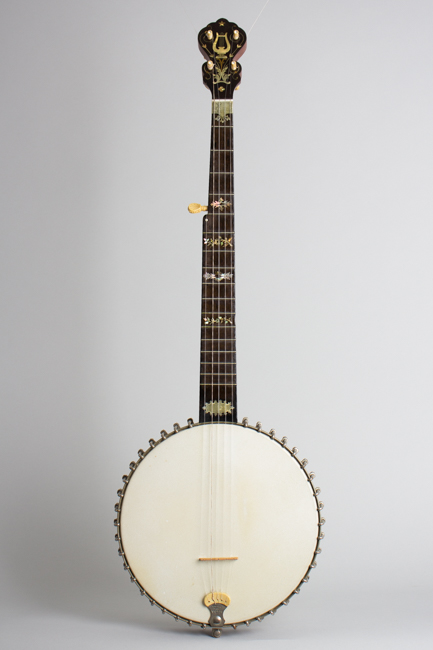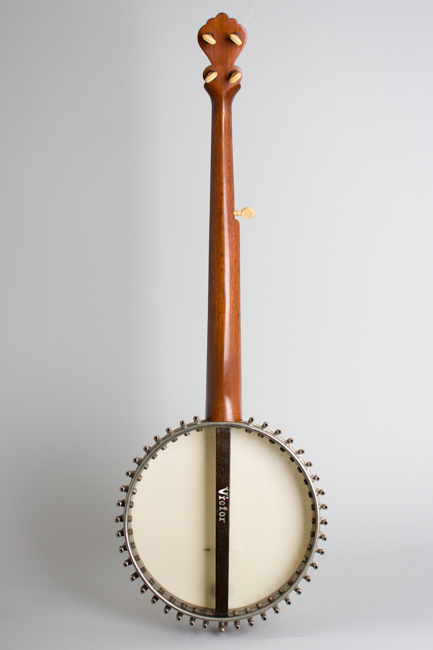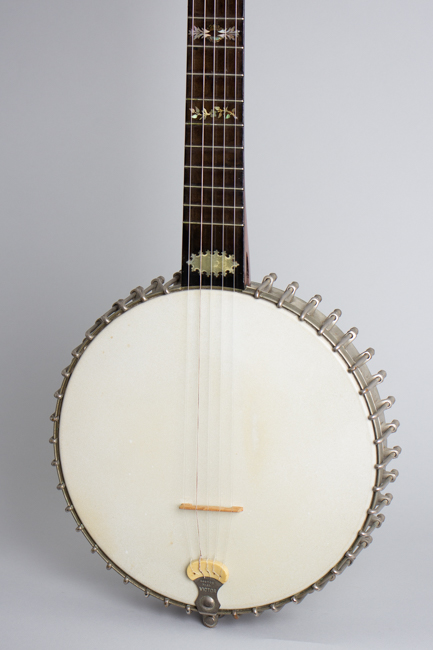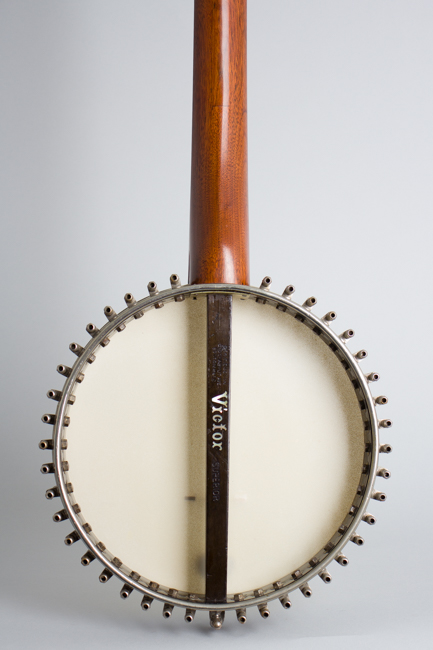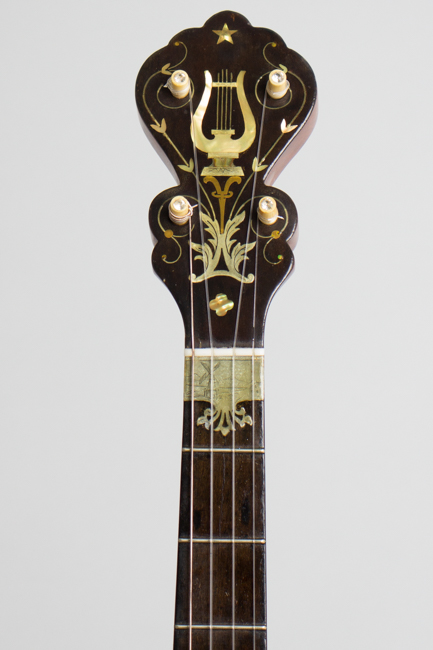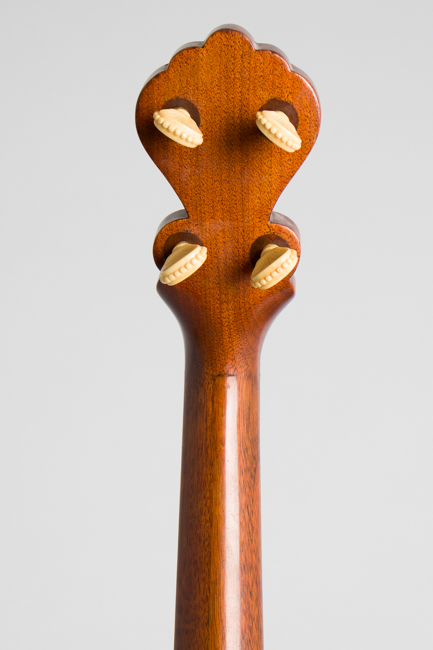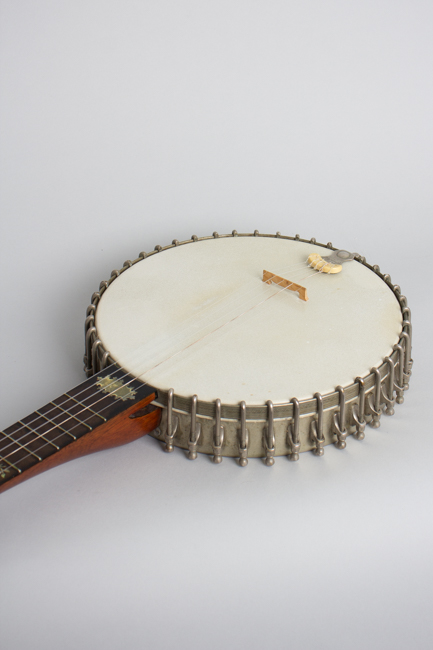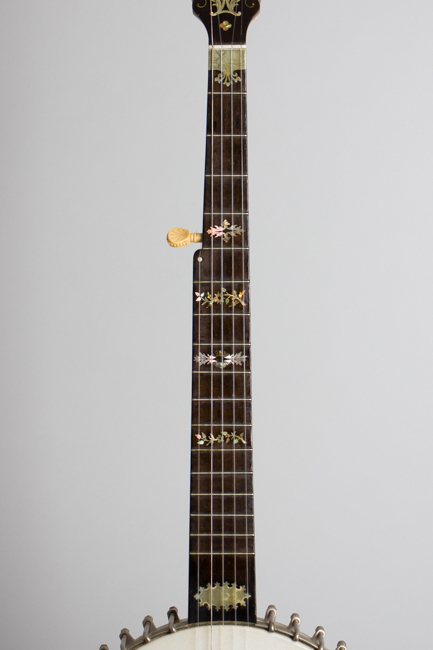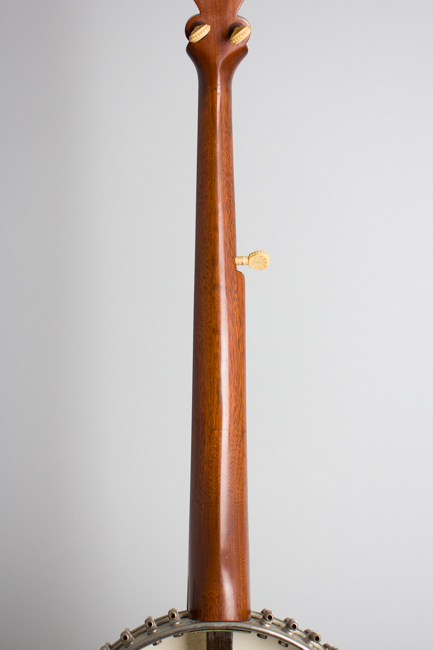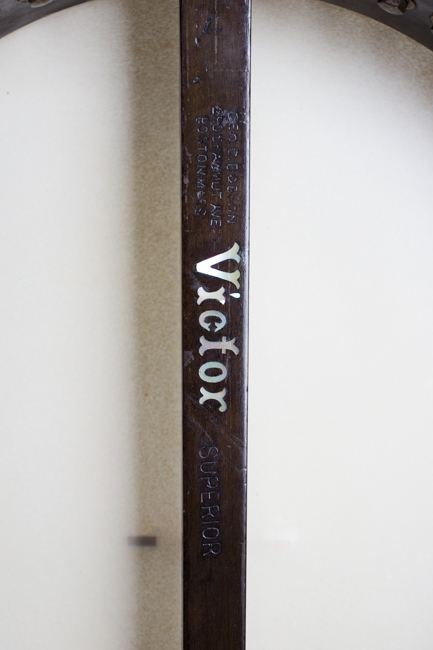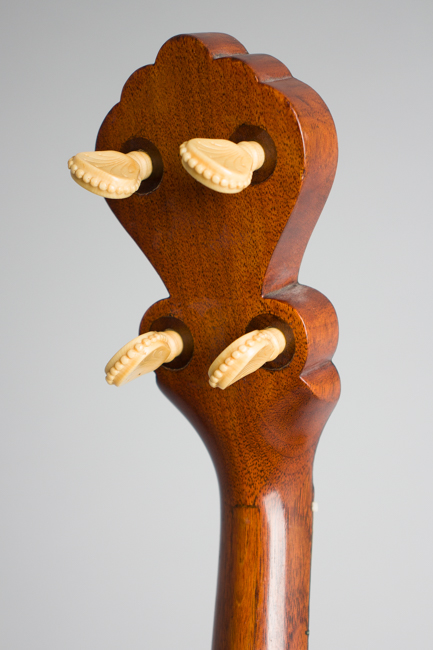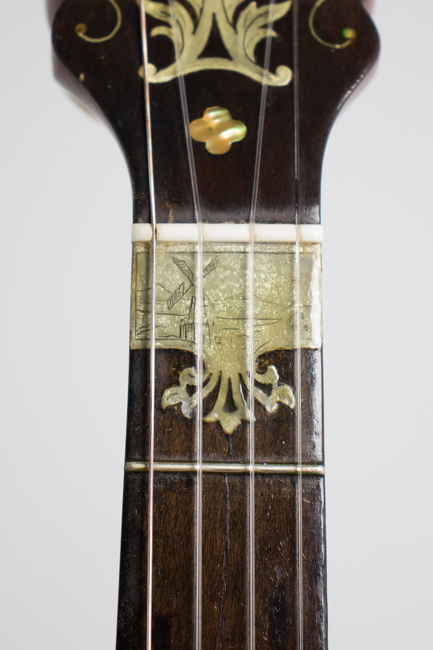George C. Dobson Victor Superior 40 bracket 5 String Banjo , c. 1888
This item has been sold.
Item # 10504
Prices subject to change without notice.
George C. Dobson Victor Superior 40 bracket Model 5 String Banjo, c. 1888, made in Boston, Mass., natural finish, spunover rim, mahogany neck with ebony fingerboard, black gig bag case.
One of several banjo-centric brothers active in the last half of the 19th century, George C. Dobson was a prominent banjo player and especially teacher in the 1880s and '90s. "George C. Dobson's New School for the Banjo" was originally published in 1877 and was one of the most popular methods of the day, based on tablature instead of note reading. He also published his own magazine and (like many other in his profession) offered a line of special banjos for sale branded with his name. These were mostly made by the J. H. Buckbee Company of New York, but in the 1880s Dobson's studio was located in Boston, so they carry a Boston address.
Dobson's "Victor" banjos were offered in a variety of styles and prices. This "Superior" model was the next to the top of the line and priced at $60 in Dodson's literature, quite a sum for the time. It is a very high quality banjo for the time with a solid spunover rim mounting a plethora of hooks, an engraved hoop, a real ebony fingerboard with intricately cut pearl inlay and a lovely pearl-and-wire ornamented peghead. "Victor" is inlaid into the dowel in pearl, the ivoroid tuners are quite fancy as well. The special ivoroid-capped tailpiece and dowel are marked with Dobson's Boston address.
This is a very good playing and sounding banjo, especially well preserved for its age. The neck in the lower positions is VERY slim for the period, even compared to most modern banjos. In the 1880s competitor S.S. Stewart continuously denigrated the Dobson banjos and methods, but on the evidence of this one at least some of his instruments were as good as any being made.
Overall length is 34 5/8 in. (87.9 cm.), 11 in. (27.9 cm.) diameter head, and 2 1/4 in. (5.7 cm.) in depth, measured at side of rim. Scale length is 25 in. (635 mm.). Width of nut is 1 3/16 in. (30 mm.).
This banjo is in excellent condition for its age, something like 135 years on still quite a functional instrument. It looks like the entire neck (including the fingerboard) dowel finish and interior rim were lightly overcoated long ago, so the patina is not as old as it would naturally be but still has some age to it. There is not much finish wear, and the plating is surprisingly clean as well. There is a metal plate added to the inside rim around the dowel joint, probably to cover some screws set into the heel.\ to secure the neck joint.
The head is very thin hand-tucked plastic, an unusual but surprisingly effective way of doing it. Apart from this, a replaced string nut and the handmade bridge all the hardware on the banjo is original. The neck is quite straight, the original frets have virtually no wear (it was a gut-string banjo) and playability is excellent. This is an excellent instrument within its 19th century limits (gut or nylon strings only, please!) and a lovely authentic player. Overall Excellent - Condition.
One of several banjo-centric brothers active in the last half of the 19th century, George C. Dobson was a prominent banjo player and especially teacher in the 1880s and '90s. "George C. Dobson's New School for the Banjo" was originally published in 1877 and was one of the most popular methods of the day, based on tablature instead of note reading. He also published his own magazine and (like many other in his profession) offered a line of special banjos for sale branded with his name. These were mostly made by the J. H. Buckbee Company of New York, but in the 1880s Dobson's studio was located in Boston, so they carry a Boston address.
Dobson's "Victor" banjos were offered in a variety of styles and prices. This "Superior" model was the next to the top of the line and priced at $60 in Dodson's literature, quite a sum for the time. It is a very high quality banjo for the time with a solid spunover rim mounting a plethora of hooks, an engraved hoop, a real ebony fingerboard with intricately cut pearl inlay and a lovely pearl-and-wire ornamented peghead. "Victor" is inlaid into the dowel in pearl, the ivoroid tuners are quite fancy as well. The special ivoroid-capped tailpiece and dowel are marked with Dobson's Boston address.
This is a very good playing and sounding banjo, especially well preserved for its age. The neck in the lower positions is VERY slim for the period, even compared to most modern banjos. In the 1880s competitor S.S. Stewart continuously denigrated the Dobson banjos and methods, but on the evidence of this one at least some of his instruments were as good as any being made.
Overall length is 34 5/8 in. (87.9 cm.), 11 in. (27.9 cm.) diameter head, and 2 1/4 in. (5.7 cm.) in depth, measured at side of rim. Scale length is 25 in. (635 mm.). Width of nut is 1 3/16 in. (30 mm.).
This banjo is in excellent condition for its age, something like 135 years on still quite a functional instrument. It looks like the entire neck (including the fingerboard) dowel finish and interior rim were lightly overcoated long ago, so the patina is not as old as it would naturally be but still has some age to it. There is not much finish wear, and the plating is surprisingly clean as well. There is a metal plate added to the inside rim around the dowel joint, probably to cover some screws set into the heel.\ to secure the neck joint.
The head is very thin hand-tucked plastic, an unusual but surprisingly effective way of doing it. Apart from this, a replaced string nut and the handmade bridge all the hardware on the banjo is original. The neck is quite straight, the original frets have virtually no wear (it was a gut-string banjo) and playability is excellent. This is an excellent instrument within its 19th century limits (gut or nylon strings only, please!) and a lovely authentic player. Overall Excellent - Condition.
